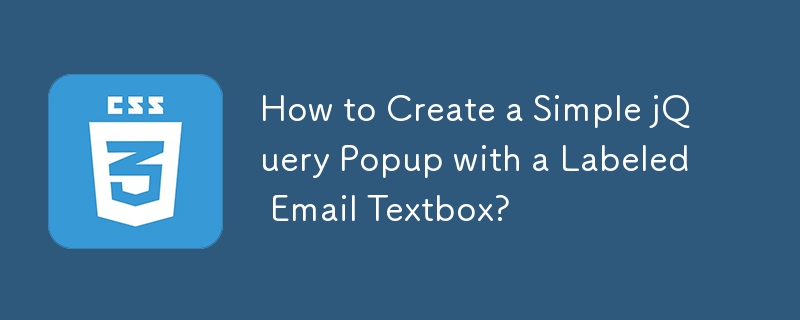How to Create a Simple jQuery Popup with a Labeled Email Textbox?
Dec 19, 2024 am 01:22 AM
Creating a Simple Popup with jQuery
When designing web pages, you may encounter situations where you want to display additional information or content in a separate popup window upon a specific user action. This article will guide you through the process of creating a simple popup using jQuery, focusing on displaying a labeled email text box.
Step 1: CSS Styling
First, define the CSS styles to customize the appearance of the popup.
a.selected {
background-color: #1F75CC;
color: white;
z-index: 100;
}
.messagepop {
background-color: #FFFFFF;
border: 1px solid #999999;
cursor: default;
display: none;
margin-top: 15px;
position: absolute;
text-align: left;
width: 394px;
z-index: 50;
padding: 25px 25px 20px;
}
label {
display: block;
margin-bottom: 3px;
padding-left: 15px;
text-indent: -15px;
}
.messagepop p, .messagepop.div {
border-bottom: 1px solid #EFEFEF;
margin: 8px 0;
padding-bottom: 8px;
}
This CSS defines styles for the popup element, the linked element that triggers the popup, labels, and paragraph elements within the popup.
Step 2: JavaScript Functionality
Next, create the JavaScript functions to handle the popup behavior:
function deselect(e) {
$('.pop').slideFadeToggle(function() {
e.removeClass('selected');
});
}
$(function() {
$('#contact').on('click', function() {
if($(this).hasClass('selected')) {
deselect($(this));
} else {
$(this).addClass('selected');
$('.pop').slideFadeToggle();
}
return false;
});
$('.close').on('click', function() {
deselect($('#contact'));
return false;
});
});
$.fn.slideFadeToggle = function(easing, callback) {
return this.animate({ opacity: 'toggle', height: 'toggle' }, 'fast', easing, callback);
};
- deselect(): This function closes the popup and removes the selected state from the linked element.
- $('#contact').on('click', ...): This event handler toggles the visibility of the popup when the element with the ID of 'contact' is clicked.
- $('.close').on('click', ...): This event handler closes the popup when the 'close' element is clicked.
- $.fn.slideFadeToggle: This custom function smoothly fades and toggles the visibility of the popup.
Step 3: HTML Structure
Finally, define the HTML structure for the popup and the linked element:
<div class="messagepop pop"> <form method="post">
This HTML defines the popup content, including a form with an email input and a message textarea, as well as the linked element with an ID of 'contact'.
By combining these steps, you can create a simple popup that appears when the 'Contact Us' link is clicked and contains a labeled email text box. This technique can be easily customized and adapted to meet your specific requirements.
The above is the detailed content of How to Create a Simple jQuery Popup with a Labeled Email Textbox?. For more information, please follow other related articles on the PHP Chinese website!

Hot AI Tools

Undress AI Tool
Undress images for free

Undresser.AI Undress
AI-powered app for creating realistic nude photos

AI Clothes Remover
Online AI tool for removing clothes from photos.

Clothoff.io
AI clothes remover

Video Face Swap
Swap faces in any video effortlessly with our completely free AI face swap tool!

Hot Article

Hot Tools

Notepad++7.3.1
Easy-to-use and free code editor

SublimeText3 Chinese version
Chinese version, very easy to use

Zend Studio 13.0.1
Powerful PHP integrated development environment

Dreamweaver CS6
Visual web development tools

SublimeText3 Mac version
God-level code editing software (SublimeText3)

Hot Topics
 What is 'render-blocking CSS'?
Jun 24, 2025 am 12:42 AM
What is 'render-blocking CSS'?
Jun 24, 2025 am 12:42 AM
CSS blocks page rendering because browsers view inline and external CSS as key resources by default, especially with imported stylesheets, header large amounts of inline CSS, and unoptimized media query styles. 1. Extract critical CSS and embed it into HTML; 2. Delay loading non-critical CSS through JavaScript; 3. Use media attributes to optimize loading such as print styles; 4. Compress and merge CSS to reduce requests. It is recommended to use tools to extract key CSS, combine rel="preload" asynchronous loading, and use media delayed loading reasonably to avoid excessive splitting and complex script control.
 External vs. Internal CSS: What's the Best Approach?
Jun 20, 2025 am 12:45 AM
External vs. Internal CSS: What's the Best Approach?
Jun 20, 2025 am 12:45 AM
ThebestapproachforCSSdependsontheproject'sspecificneeds.Forlargerprojects,externalCSSisbetterduetomaintainabilityandreusability;forsmallerprojectsorsingle-pageapplications,internalCSSmightbemoresuitable.It'scrucialtobalanceprojectsize,performanceneed
 Does my CSS must be on lower case?
Jun 19, 2025 am 12:29 AM
Does my CSS must be on lower case?
Jun 19, 2025 am 12:29 AM
No,CSSdoesnothavetobeinlowercase.However,usinglowercaseisrecommendedfor:1)Consistencyandreadability,2)Avoidingerrorsinrelatedtechnologies,3)Potentialperformancebenefits,and4)Improvedcollaborationwithinteams.
 CSS Case Sensitivity: Understanding What Matters
Jun 20, 2025 am 12:09 AM
CSS Case Sensitivity: Understanding What Matters
Jun 20, 2025 am 12:09 AM
CSSismostlycase-insensitive,butURLsandfontfamilynamesarecase-sensitive.1)Propertiesandvalueslikecolor:red;arenotcase-sensitive.2)URLsmustmatchtheserver'scase,e.g.,/images/Logo.png.3)Fontfamilynameslike'OpenSans'mustbeexact.
 What is Autoprefixer and how does it work?
Jul 02, 2025 am 01:15 AM
What is Autoprefixer and how does it work?
Jul 02, 2025 am 01:15 AM
Autoprefixer is a tool that automatically adds vendor prefixes to CSS attributes based on the target browser scope. 1. It solves the problem of manually maintaining prefixes with errors; 2. Work through the PostCSS plug-in form, parse CSS, analyze attributes that need to be prefixed, and generate code according to configuration; 3. The usage steps include installing plug-ins, setting browserslist, and enabling them in the build process; 4. Notes include not manually adding prefixes, keeping configuration updates, prefixes not all attributes, and it is recommended to use them with the preprocessor.
 What are CSS counters?
Jun 19, 2025 am 12:34 AM
What are CSS counters?
Jun 19, 2025 am 12:34 AM
CSScounterscanautomaticallynumbersectionsandlists.1)Usecounter-resettoinitialize,counter-incrementtoincrease,andcounter()orcounters()todisplayvalues.2)CombinewithJavaScriptfordynamiccontenttoensureaccurateupdates.
 CSS: When Does Case Matter (and When Doesn't)?
Jun 19, 2025 am 12:27 AM
CSS: When Does Case Matter (and When Doesn't)?
Jun 19, 2025 am 12:27 AM
In CSS, selector and attribute names are case-sensitive, while values, named colors, URLs, and custom attributes are case-sensitive. 1. The selector and attribute names are case-insensitive, such as background-color and background-Color are the same. 2. The hexadecimal color in the value is case-sensitive, but the named color is case-sensitive, such as red and Red is invalid. 3. URLs are case sensitive and may cause file loading problems. 4. Custom properties (variables) are case sensitive, and you need to pay attention to the consistency of case when using them.
 What is the conic-gradient() function?
Jul 01, 2025 am 01:16 AM
What is the conic-gradient() function?
Jul 01, 2025 am 01:16 AM
Theconic-gradient()functioninCSScreatescirculargradientsthatrotatecolorstopsaroundacentralpoint.1.Itisidealforpiecharts,progressindicators,colorwheels,anddecorativebackgrounds.2.Itworksbydefiningcolorstopsatspecificangles,optionallystartingfromadefin






